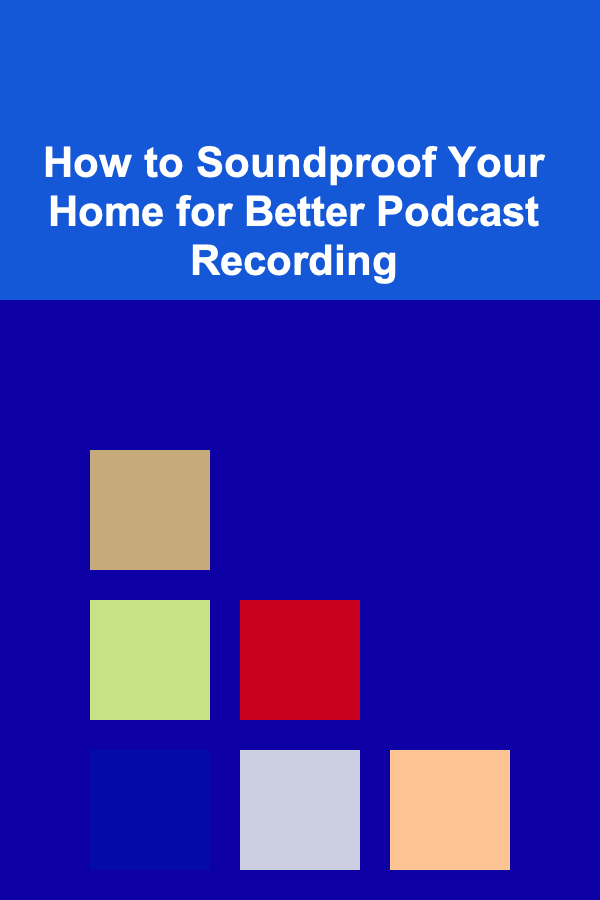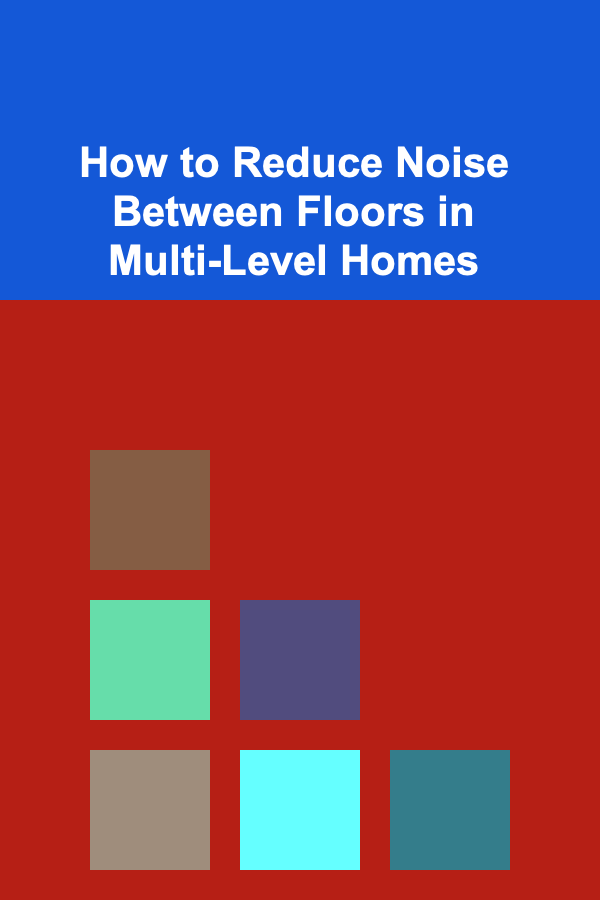
How to Soundproof Your Home for Better Podcast Recording
ebook include PDF & Audio bundle (Micro Guide)
$12.99$11.99
Limited Time Offer! Order within the next:

Podcasting has exploded in popularity over the last decade, and for good reason. It allows anyone with a microphone and an idea to reach a global audience. Whether you're an aspiring podcaster or a seasoned professional, creating high-quality content requires attention to detail. One of the most important aspects of a good podcast is the sound quality, and this starts with the environment in which you record.
Soundproofing your home for podcast recording is crucial for achieving the clarity and professionalism your audience expects. While it might sound complicated, with the right tools, techniques, and knowledge, you can transform any room into a studio-ready space. In this article, we will dive deep into the steps you can take to soundproof your home for podcast recording, from basic methods to advanced techniques.
Why Soundproofing is Crucial for Podcasting
When you're recording a podcast, you want the listener to focus solely on your voice and the content you're sharing. However, even minor background noise can detract from the listening experience. External sounds such as traffic, birds chirping, the hum of appliances, or even distant conversations can all interfere with the clarity of your podcast. These unwanted sounds can distract your audience, lower the perceived professionalism of your show, and ultimately harm your brand.
In addition to external noise, internal reflections and echoes in your room can muddy the sound, making it harder for listeners to hear every word. Therefore, soundproofing isn't just about blocking noise; it's about controlling the sound within your recording environment to ensure clarity and definition.
Understanding Soundproofing vs. Acoustic Treatment
Before we dive into specific soundproofing techniques, it's important to distinguish between soundproofing and acoustic treatment, as they are often confused.
- Soundproofing refers to methods and materials used to block sound from entering or leaving a room. This is crucial if you're recording in a noisy environment or if you need to isolate the sound within a room to avoid disturbing others.
- Acoustic treatment, on the other hand, refers to modifying the room's acoustic properties to improve sound quality within the space. This includes techniques like absorbing sound to reduce reverberation or diffusing sound to create a more balanced listening experience.
For podcasting, you will need a combination of both soundproofing and acoustic treatment to ensure optimal sound quality. While soundproofing ensures that external noises are minimized, acoustic treatment will help control the room's sound to avoid unwanted echoes or reverb.
Assessing Your Recording Environment
Before you begin soundproofing your room, you must first assess the space you're working with. Some rooms are naturally better for recording than others, and it's important to know where your room falls in terms of sound quality.
Factors to Consider:
- Location of the Room: Rooms facing busy streets or located near high-traffic areas are more likely to have noise problems. If possible, choose a room at the back of the house, away from windows and external walls.
- Size and Shape of the Room: Smaller rooms may have more issues with sound reflections and reverberation. Similarly, rooms with a rectangular shape can create problematic sound waves that bounce back and forth, creating echoes.
- Hard Surfaces: Rooms with hard surfaces like tile floors, concrete walls, or large windows tend to amplify sound, causing more echoes. These are the areas where acoustic treatment can be particularly beneficial.
- External Noise Sources: Identify where unwanted noises are coming from---whether it's traffic, nearby construction, or even a neighbor's air conditioning. This will help you determine the type of soundproofing measures you need to take.
Once you have a clear understanding of your room's acoustic properties and external noise factors, you can start planning how to address these challenges.
Steps to Soundproof Your Home for Podcast Recording
1. Seal All Gaps and Cracks
One of the simplest and most cost-effective ways to soundproof a room is by sealing all gaps and cracks. Even the smallest gaps can let in a surprising amount of sound. These gaps are commonly found around doors, windows, baseboards, and electrical outlets.
Key Areas to Seal:
- Doors: Use door sweeps to seal the bottom of the door, and weatherstripping around the edges. Solid-core doors are better than hollow-core doors for soundproofing.
- Windows: If your room has windows, consider using thick curtains or window inserts to block external noise. Alternatively, double-glazing windows can provide significant soundproofing benefits.
- Walls: Look for cracks or gaps in the walls, particularly around electrical outlets, vents, and corners. Acoustic sealant can help close these gaps.
By addressing these small openings, you prevent sound from leaking in or out, ensuring a quieter and more controlled recording space.
2. Use Mass-Loaded Vinyl (MLV)
Mass-loaded vinyl is a dense material that is used to block sound transmission through walls, ceilings, and floors. It's an effective soundproofing material that can be installed in a variety of ways to reduce the amount of noise entering or leaving your room.
MLV can be attached to walls, ceilings, or floors, or it can be used in conjunction with other materials like drywall to enhance its effectiveness. If you're renting or don't want to make permanent changes to your space, MLV can be a great solution since it can be installed and removed relatively easily.
3. Add Soundproofing Insulation
Adding soundproofing insulation within your walls, ceilings, or floors is an excellent way to reduce sound transmission between rooms. Materials like fiberglass, cellulose, or rock wool are often used for soundproofing purposes because they are dense and can absorb sound effectively.
For podcast recording, the focus should be on blocking sounds from neighboring rooms or external noise. Insulating the walls between your recording room and noisy areas, like shared walls or floors, will significantly improve your soundproofing efforts.
4. Use Acoustic Panels for Internal Treatment
While soundproofing focuses on blocking sound from entering or leaving the room, acoustic treatment focuses on improving the sound inside the room itself. Acoustic panels are designed to absorb sound waves and reduce reflections that can cause echo or reverberation.
When installing acoustic panels, focus on the areas where sound tends to bounce around the most. These include the walls facing your microphone, the ceiling above, and the corners of the room.
- Foam Panels: These are the most common type of acoustic treatment. They come in various shapes and sizes and are designed to absorb mid- and high-frequency sounds.
- Fabric-Wrapped Panels: For a more professional look, you can opt for fabric-wrapped acoustic panels that provide excellent absorption properties and can be customized to match the aesthetics of your room.
5. Add Bass Traps to Control Low Frequencies
Bass traps are specialized acoustic panels designed to absorb low-frequency sounds (bass), which are often the most difficult to control. These sounds tend to build up in the corners of a room and can cause an unwanted "boomy" effect in your recordings.
Place bass traps in the room's corners to prevent these low frequencies from bouncing around and muddying the sound. A combination of bass traps and regular acoustic panels will help you achieve a more balanced sound.
6. Install Carpeting and Rugs
Hard floors, such as tile or hardwood, can cause sound to bounce around and create unwanted reverberation. To combat this, consider adding thick carpeting or rugs to your room. Carpet helps absorb sound, preventing it from reflecting off the floor.
If you don't want to cover the entire floor, strategically place rugs in areas where sound tends to reflect most. This is particularly helpful for controlling mid-to-high frequency sounds.
7. Soundproof the Ceiling
The ceiling is often overlooked when it comes to soundproofing, but it's an important surface for sound transmission. If you're recording in a second-story room or in an apartment, sound may travel through the ceiling and disturb others below.
To soundproof the ceiling, you can add acoustic tiles or foam panels. If you're looking for a more permanent solution, installing a layer of drywall with soundproofing insulation can help block sound from traveling through the ceiling.
8. Use a Quality Microphone and Audio Equipment
While soundproofing your room is essential, the equipment you use plays a significant role in the quality of your podcast. Invest in a high-quality microphone that minimizes background noise and has directional pickup patterns, such as a cardioid or supercardioid microphone.
Additionally, using a pop filter can help reduce plosive sounds (like "p" and "t" sounds) that can distort your voice and detract from the audio quality.
Additional Tips for Better Podcast Sound Quality
1. Record During Quiet Hours
If you're in a busy area, recording during the quietest hours of the day, such as early mornings or late evenings, can help reduce external noise. Traffic and construction are often less active during these times, giving you a more peaceful environment for recording.
2. Create a DIY Booth
For an added layer of sound isolation, consider creating a DIY podcast booth. This can be as simple as setting up a portable acoustic shield around your microphone or building a small recording booth with soundproofing materials like foam panels and insulation.
3. Use Soundproofing Curtains
Soundproof curtains are designed to block out external noise while also improving room acoustics. They are a good alternative if you can't install permanent soundproofing materials, especially if you have large windows that let in a lot of noise.
Conclusion
Soundproofing your home for podcast recording is a necessary step toward producing high-quality content that resonates with your audience. By sealing gaps, adding mass-loaded vinyl, using acoustic treatments, and employing soundproofing materials, you can create a recording environment that minimizes external noise and ensures clear, professional sound.
Remember that soundproofing is a balance between blocking external noise and controlling internal acoustics. With the right combination of techniques and materials, you'll be able to craft a podcast studio in your own home that delivers the best possible sound to your listeners.
Reading More From Our Other Websites
- [Home Security 101] How to Lock Your Home Properly for Maximum Security
- [Home Party Planning 101] How to Host a Casual Get-together with Minimal Stress: Your Guide to Effortless Home Entertaining
- [Organization Tip 101] How to Teach Kids About Car Organization from an Early Age
- [Home Storage Solution 101] How to Organize Your Garage with Creative Shelving Ideas
- [Home Cleaning 101] How to Clean Your Home Efficiently on a Budget
- [Rock Climbing Tip 101] Gear Guide: Choosing the Perfect Shoes, Harnesses, and Ropes for Sport Climbing
- [Home Space Saving 101] How to Use Furniture Layout to Create Flow in Small Homes
- [Home Pet Care 101] How to Deal with Separation Anxiety in Pets While You're at Home
- [Personal Care Tips 101] How to Combine Hair Mousse with Other Styling Products
- [Organization Tip 101] Why You Should Consider a Mobile Storage Solution

How to Build a Checklist for Understanding Market Needs and Pain Points
Read More
How to Create an Inviting Outdoor Space for Renters
Read More
How to Reduce Noise Between Floors in Multi-Level Homes
Read More
How to Handle Conflict in a Remote Workplace
Read More
How to Cultivate Unconditional Love
Read More
How to Prepare Your Home for a Move-Out Checklist
Read MoreOther Products

How to Build a Checklist for Understanding Market Needs and Pain Points
Read More
How to Create an Inviting Outdoor Space for Renters
Read More
How to Reduce Noise Between Floors in Multi-Level Homes
Read More
How to Handle Conflict in a Remote Workplace
Read More
How to Cultivate Unconditional Love
Read More